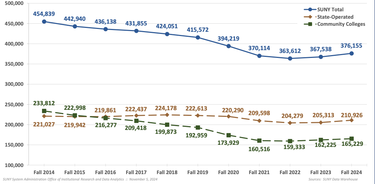SUNY enrollment increases, diversifies
While first-year college enrollment is down nationwide by 5 percent, New York’s statewide university system is reporting an increase for the second year in a row.
Last year, SUNY-wide enrollment was up for the first time in a decade, by 1 percent. This year, enrollment is up another 2.3 percent for a total of 3.4 percent over two years.
A total of 376,155 students are currently enrolled across the SUNY system.
In Albany County, the University at Albany, with an uptown campus partly in Guilderland, saw a jump of 5.4 percent over two years, according to a recently released report on SUNY enrollment.
Other Capital Region colleges did not fare as well. Over those same two years, enrollment at Hudson Valley Community College was up 0.4 percent while enrollment at Schenectady County Community College was down 4.4 percent.
First-time enrollment SUNY-wide is also up again this year for a 5.2 percent increase over two years. At UAlbany, that increase is 7.1 percent.
Enrollment in doctoral programs state-wide has increased over the decade, from about 105,000 in 2014 to about 114,000 now.
At the same time, enrollment at comprehensive colleges has decreased from roughly 89,000 a decade ago to about 73,000 now.
The decline at technology colleges has been far less severe, from about 26,000 in 2014 to roughly 25,000 now.
The student body at SUNY schools is becoming more diverse. For the first time, enrollment of white students in the SUNY system came in below the 50-percent mark, and is at 49.1 percent this year, down from 59.6 percent a decade ago.
This year, enrollment of Hispanic or Latino students is at 16.6 percent, enrollment of Black students is at 10.7 percent, enrollment of Asian students is at 8.6 percent, and enrollment of international students is at 5.7 percent.
SUNY undergraduate first-time enrollment shows even more diversity with enrollment of white students currently at 45.3 percent, down from 57.7 percent a decade ago.
This year, for first-time enrollment, Hispanic or Latino students make up 20.1 percent while enrollment of Black students is at 13.1 percent, enrollment of Asian students is at 8.7 percent, and enrollment of international students is at 3.5 percent.
Among incoming first-year undergraduates, SUNY reported increases in the share of Pell recipients, an indicator of students from low-income backgrounds, from 46.7 percent in 2023 to 49.7 percent this year, and in students who are under-represented by race/ethnicity from 35.7 percent last year to 36.5 percent this year.
“These trends are particularly important in light of the U.S. Supreme Court’s 2023 ruling on race-conscious college admissions,” said a release from the governor’s office, announcing the enrollment numbers.
“As governor,” Kathy Hochul said in the release, “I have remained committed to increasing access to our colleges and universities — from removing financial barriers and expanding our tuition assistance program to launching SUNY's first ever direct admissions program.
“Every New Yorker deserves the opportunity to pursue higher education,” she went on, “and I look forward to building on this progress to ensure even more students can enroll at one of our world class institutions.”
The release also noted the U.S. News & World Report 2025 Best Colleges Rankings named all four of the state’s university centers — at Albany (121), Binghamton (73), Buffalo (76), and Stony Brook (58) — among the top national universities, while Farmingdale led for SUNY in the regional colleges (north) category at number 6, followed in the top 20 by SUNY Canton (9), Alfred State (10); SUNY Cobleskill (10), SUNY Geneseo (13), SUNY Delhi (14) and SUNY New Paltz (19).



